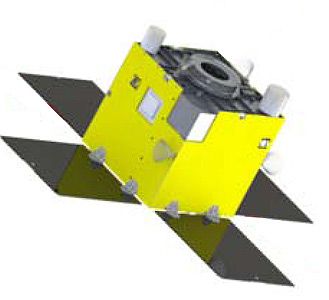
Home - Search - Browse - Alphabetic Index: 0- 1- 2- 3- 4- 5- 6- 7- 8- 9
A- B- C- D- E- F- G- H- I- J- K- L- M- N- O- P- Q- R- S- T- U- V- W- X- Y- Z
PROCYON
FURTHER INFORMATION ON THIS TOPIC AT OUR PARTNER SITE
 PROCYON Credit: Manufacturer Image |
Status: Operational 2015. First Launch: 2014-12-03. Last Launch: 2014-12-03. Number: 1 . Gross mass: 59 kg (130 lb).
NASA NSSDC Master Catalog Description
PROCYON, the PRoximate Object Close flYby with Optical Navigation, is a small satellite launched as a secondary payload with Hayabusa 2. The spacecraft will make a close flyby of one or more asteroids. The principal objectives of PROCYON are demonstration of a deep space exploration micro-satellite bus system; power generation, thermal control, attitude control, communication, and orbit determination in deep space; and orbit control by a small electric propulsion system. The secondary goals include communication using a high-efficiency GaNX-band power amplifier; precise delta differential one-way range determination (DDOR) navigation in deep space; optical navigation to encounter an asteroid; and asteroid close flyby observations.
Spacecraft and Subsystems
The spacecraft body is cube-shaped, 67 x 55 x 55 cm, with four solar panels, each roughly a 47 x 47 cm square, extending from the top. Total dry mass of the spacecraft is 65.5 kg, with an additional (approximately) 2 kg of xenon for propulsion. Mounted on the top of the spacecraft are a flat X-band high gain antenna and two small isoflux X-band low-gain antennae, one for uplink and one for downlink. An identical set of low gain antennae are mounted on the bottom. A flat X-band medium gain antenna is mounted on one of the sides. Communications are via a 15-W GaN-based solid state power amplifier and X-band transponder.
Attitude control is achieved with 8 Xe cold gas thrusters, each 19 mN. All are mounted along the center of the intersections between the faces of the cube, four on the sides, two on top, and two on the bottom. There are four reaction wheels, a 3-axis Fiber Optic Gyro, a star tracker, and five non-spin Sun aspect sensors. The main Xenon ion thruster, 250 microNewtons, is mounted (non-gimbaled) on one side of the spacecraft body. One of the bottom corners holds a rotatable telescope, which is used for navigation and asteroid observation.
Mission Profile
PROCYON was launched with Hayabusa 2 on 3 December 2014 at 04:22:04 UT (13:22:04 local Japanese Time) from the Tanegashima Space Center on an H2A rocket. After an Earth gravity-assist swingby in December 2015 it will fly by an asteroid sometime in early 2016, followed by possible other asteroid encounters. During a flyby, it will use optical line-of-sight control to pass within an altitude of approximately 30-50 km at a relative velocity of less than 10 km/sec.
More at: PROCYON.
Country: Japan.
Back to top of page
Home - Search - Browse - Alphabetic Index: 0- 1- 2- 3- 4- 5- 6- 7- 8- 9
A- B- C- D- E- F- G- H- I- J- K- L- M- N- O- P- Q- R- S- T- U- V- W- X- Y- Z
© 1997-2019 Mark Wade - Contact
© / Conditions for Use